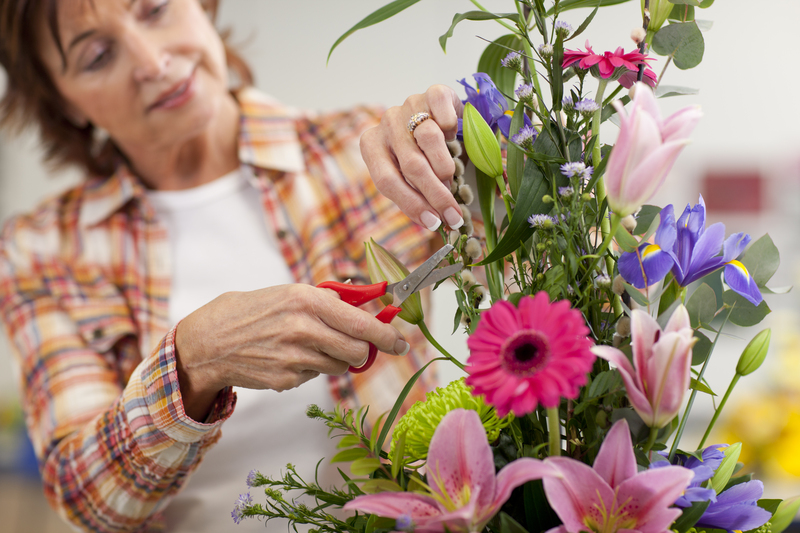3 Innovative Methods for Flower Preservation
Posted on 14/08/2025
3 Innovative Methods for Flower Preservation
Flowers captivate us with their vibrant colors and delicate fragrances. Yet, their fleeting beauty often means we only enjoy them for a short while. Thanks to advancements in flower preservation techniques, it's now easier than ever to keep your treasured blossoms looking fresh and beautiful for months or even years. If you're seeking new ways to preserve your floral arrangements, you're in the right place. In this comprehensive guide, we'll uncover three innovative methods for keeping your favorite flowers intact and vibrant far beyond their natural lifespan.

Why Choose Innovative Flower Preservation Techniques?
Traditional flower preservation, such as simply pressing blooms between book pages or hanging bouquets upside-down, can lead to faded colors and brittle petals. Newer, more advanced methods offer the chance to retain the natural beauty, texture, and even scent of your favorite flowers. Whether you want to keep wedding bouquets, honor a special occasion, or create unique home decor, these cutting-edge techniques open new possibilities for long-term flower preservation.
Method 1: Silica Gel Flower Drying
What Is Silica Gel Flower Drying?
Using silica gel is a modern twist on flower drying that delivers far better results than traditional air drying. Silica gel is a desiccant -- a substance that absorbs moisture. It surrounds the flower, extracting water efficiently while preserving both its vibrant color and intricate shape. This makes it one of the best flower preservation techniques for those wanting natural-looking results.
How to Preserve Flowers with Silica Gel
- Choose Fresh Flowers: Pick recently bloomed flowers with no signs of wilting to ensure the best end result.
- Prepare a Container: Use an airtight plastic or glass container large enough to fit your flowers without squashing them.
- Add Silica Gel: Pour a layer of silica gel crystals at the bottom, then place your flowers on top (face up).
- Gently Cover the Flowers: Carefully spoon or pour more silica gel around and over the petals, making sure the flowers are fully surrounded without damaging them.
- Seal and Wait: Close the container tightly. Let your flowers dry for 2-7 days, depending on thickness and size.
- Remove and Clean: Once dried, gently pour off the silica gel and carefully remove your flowers. Brush away any remaining crystals with a soft brush.
Benefits of Silica Gel Drying
- Preserves shapes and colors: Retains more of the original flower's beauty than many other methods.
- Quick and efficient: Flowers are preserved within just a few days.
- Reusable: Silica gel can be reused multiple times, making it a sustainable solution for repeat projects.
Best Flowers for Silica Gel Preservation
- Roses
- Daisies
- Orchids
- Zinnias
- Carnations
Method 2: Flower Preservation via Freeze Drying
Understanding Freeze Drying for Flowers
Freeze drying (lyophilization) is a high-tech process that removes moisture from flowers via sublimation, the transformation of ice directly into vapor. This method is a favorite among professional florists and preservationists for its ability to keep flowers looking almost freshly picked. The flowers' color, structure, and scent can remain nearly intact for years, making freeze dried flowers a premium choice for keepsakes and decorative purposes.
How Does Freeze Drying Work?
- Pre-freezing: Flowers are placed in a freezer at sub-zero temperatures to lock in their color and shape.
- Vacuum Chamber: Once frozen, flowers are transferred to a vacuum chamber.
- Sublimation: In the vacuum, ice within the flowers turns directly into vapor, bypassing the liquid state and leaving the flowers perfectly dried.
- Sealing: The preserved flowers can then be arranged as desired, protected with a fixative spray if needed.
Advantages of Freeze Dried Flower Preservation
- Unmatched longevity: Properly freeze dried flowers can last for years without losing their shape or color.
- Preserves structure: Petals, stems, and even complex inflorescences maintain their original form.
- Wide variety: Suitable for many flower types, even delicate varieties like lilies and tulips.
Best Occasions and Uses for Freeze Dried Flowers
- Wedding bouquets
- Graduation corsages
- Commemorative arrangements
- Home decor art projects
Note: Freeze drying typically requires specialized equipment, making this process more suitable for professional services or those willing to invest in the necessary machinery.
Method 3: Resin Encapsulation for Flower Preservation
What Is Resin Flower Preservation?
Encapsulating flowers in clear resin is one of the most impressive and creative ways to immortalize their beauty. The result is a stunning, glass-like sculpture where your favorite flowers are frozen in time. This method is increasingly popular for jewelry, paperweights, and custom home decor. Resin presents a modern approach to innovative flower preservation that goes beyond simple drying, allowing you to create unique, personalized keepsakes.
How to Preserve Flowers in Resin
- Dry the Flowers: Only thoroughly dried flowers should be used--silica gel drying is ideal.
- Prepare the Mold: Choose a silicone mold in your desired shape--coaster, sphere, pendant, or block.
- Mix the Resin: Use a two-part epoxy resin, mixing according to the product instructions.
- Pour the First Layer: Pour a thin layer of resin into the mold and let it set slightly.
- Add Flowers: Carefully position your dried flowers in the semi-set resin. Use tweezers for precision.
- Pour Additional Resin: Gently add more resin to cover and encase the flowers completely.
- Remove Bubbles: Use a toothpick or a heat source to remove any trapped air bubbles.
- Cure and Demold: Allow the resin to fully cure (usually 24-48 hours), then carefully remove your preserved flower piece from the mold.
Benefits of Resin Encapsulation
- Permanent protection: Seals flowers from air and moisture, preventing deterioration.
- Creative opportunities: Incorporate glitter, pigments, or keepsake items for personalized art.
- Functional art: Create jewelry, paperweights, ornaments, and decorative objects.
Tips for Successful Flower Resin Preservation
- Fully dry flowers: Moisture can cause discoloration or bloating inside resin.
- Work in layers: Pour resin in stages for intricate designs and thorough coverage.
- Be patient: Rushing the curing process can result in imperfections or bubbles.
Comparing Innovative Flower Preservation Methods
| Method | Result | DIY Friendly | Longevity | Best Uses |
|---|---|---|---|---|
| Silica Gel Drying | Natural look, vibrant colors | Yes | Months to years | Bouquets, single blooms, crafts |
| Freeze Drying | Near-fresh appearance | No (requires pro equipment) | Years | Weddings, keepsakes, displays |
| Resin Encapsulation | Clear, glossy, artistic | Yes | Decades | Jewelry, decor, gifts |
Choosing the Best Preservation Technique for Your Needs
Selecting the right modern flower preservation method depends on your intended use and experience level. If you're looking for a DIY approach to make wall art or crafts, silica gel drying might be ideal. For brides and preserving meaningful arrangements in nearly flawless, lifelike condition, consider professional freeze drying services. If you love custom jewelry or enjoy working with new craft materials, resin flower preservation is the perfect creative avenue. Whatever your goal, today's innovative techniques can turn fleeting blooms into lasting treasures.

Frequently Asked Questions about Innovative Flower Preservation
Can I combine preservation methods for better results?
Absolutely. Many crafters first dry flowers with silica gel, then encapsulate them in resin for enhanced longevity and visual appeal.
How long do preserved flowers last?
When properly preserved, flowers can last from several months (silica gel) to many years (resin and freeze drying). Protecting from direct sunlight and moisture extends their lifespan.
Are preserved flowers safe from mold?
As long as flowers are completely dry before resin or freeze drying, they are usually safe from mold. Any residual moisture, however, can lead to decay.
Can all flowers be preserved with these methods?
Most, but not all. Very thick-stemmed or fleshy flowers may not fare as well. Always research each flower's characteristics before preserving.
In Conclusion - The Future of Flower Preservation
Innovative flower preservation methods have transformed the way we cherish and display our favorite blooms. From the simple elegance of silica gel drying to the technical marvel of freeze drying, and the creative possibilities of resin art, today's techniques are more effective and versatile than ever. With a little patience and the right materials, you can create lasting floral memories for yourself, your family, or as unique gifts.
Whether you're saving a wedding bouquet, commemorating a special occasion, or simply enjoying a hobby, the art of modern flower preservation opens up a world of possibilities--so why not try one of these innovative methods today?
- Silica gel flower drying preserves color and shape for striking natural displays.
- Freeze drying delivers life-like, professional results for priceless keepsakes.
- Resin encapsulation turns flowers into stunning, everlasting works of art.
Preserve your memories and express your creativity by choosing the right preservation method for your needs!







